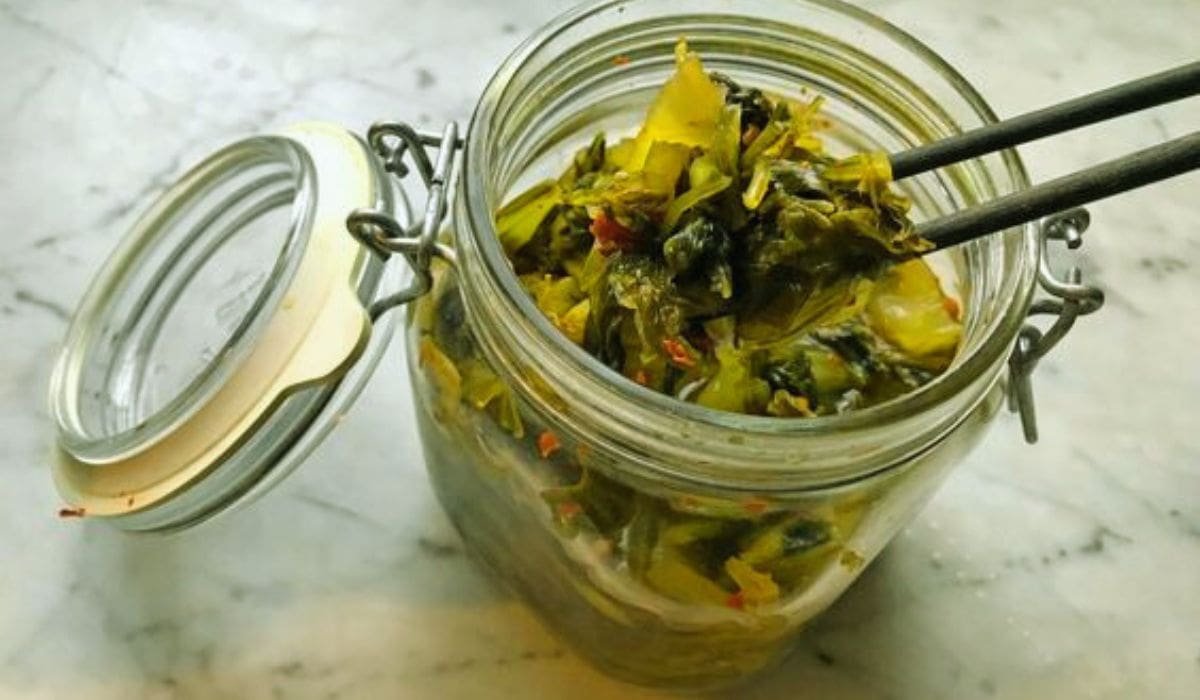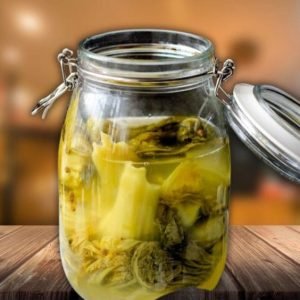Suan Cai Recipe: How to Make Pickled Chinese Mustard Greens

If you are looking for a way to make your meals more “exciting” and healthy then you might have heard about the goodness of fermented foods and their role in boosting gut health.
But perhaps the thought of making them at home seems like a difficult task (which is not as you’ll see in a bit).
That’s where the magic of Suan Cai comes in.
Did you know that in some parts of the world, fermented foods like Suan Cai are a daily staple? They’re not just tasty but packed with good bacteria that can help your stomach work better.
By the end of this Suan Cai recipe, you’ll learn how to make your own Suan Cai easily. You’ll find out how just the right amount of salt, water, and time can turn plain greens into an even more healthful treat.

Suan Cai Recipe (Pickled Chinese Mustard Greens)
Equipment
- 1 glass jar air-tight glass jar.
Ingredients
- 1 pound Chinese mustard greens Approx. 453.592 grams.
- 1 tbsp sea salt Preferably Unrefined.
- 1 large onion cut in small pieces (optional)
- 1 tsp sichuan peppercorns (optional)
- 2 cloves garlic cut in small pieces (optional)
- 2 dried chili peppers cut in small pieces (optional)
Instructions
- Rinse and clean the mustard green leaves.
- Dab the leaves dry with a paper towel.
- Coat the leaves with salt and allow them to air-dry for one hour to extract excess water.
- Stuff the greens into the jar and sprinkle peppercorns or chili pepper between each leaf.
- Throw the garlic cloves and onions in.
- Fill the jar with water.
- Seal the jar. Store it under your kitchen sink or into your storage unit for fourteen days.
- Check upon them every day and shake the jar a bit.
- When the leaves become yellowish/sour it means it is done.
Notes
- Suan Cai, in its most basic form, is just salt, water, and vegetables.
- You can change up the flavor by adding other spices like sichuan peppercorns or dried chili peppers.
- Make sure to keep it in a cool, dark place while the fermentation occurs.
- The mustard greens are ready when they turn yellowish and sour.
- You can add a other ingredients to enhance the flavor according to your preference. For example you can add coriander or ginger as well or chili pepper.
What is Suan Cai?

Suan Cai, also known as Chinese sauerkraut, is a traditional Chinese pickled vegetable that has been part of the Chinese diet for centuries. It is made by fermenting napa cabbage or Chinese mustard greens, resulting in a sour flavor that is used to enhance various dishes
According to Wikipedia, the practice of making Suan Cai dates back to ancient China, with the earliest records found in the Book of Odes from the 11th to 7th centuries BC. It was initially used as a sacrificial offering in ancestor worship ceremonies.
The technique of fermenting vegetables, such as cabbages, with rice wine to preserve them for winter consumption was developed by workers building the Great Wall of China in the 7th century BC.
During the 7th century BC, Great Wall builders where eating only rice and cabbage. They fermented cabbage with rice wine for winter preservation.
A Northern Wei Dynasty agricultural book details the production of 18 Suan Cai types, showing its widespread acceptance. [1]
Suan Cai varies by region in China. In Northern China, napa cabbage is the traditional vegetable used, while Southern and Western China prefer the thick stalk varieties of Chinese mustard greens.
Each region has its unique way of preparing and using Suan Cai in local cuisines, such as the Suan Cai hot pot in Hunan and Sichuan , stews and dumplings in Northern China , and pork sauce in Southern China .
Tips For Fermentation and Suan Cai Recipe
Before starting your Suan Cai Recipe make sure to understand the following tips:
- Make sure your Chinese mustard greens are clean: Wash the greens well to get rid of any dirt. Sometimes, leafy greens might also hide small worms and other bugs, so make sure you clean them thoroughly.
- Make sure your jars are germ-free: You need to add your jars to boiled water to kill all the germs that might have. This is very important to any fermentation project. Here’s a video on how to make your jars germ free.
- Mix the right amount of salt with water to make a saltwater mix: This step is important because it helps the good bacteria grow and stops the bad ones. If you don’t use enough salt, the food might go bad; if you use too much, it won’t ferment properly.
Mastering Suan Cai Usage
After your Suan Cai has fermented just right and tastes great, you’ll see it’s really useful in the kitchen and good for your health too. This Chinese food isn’t only for making things taste better—it’s full of good bacteria that help your stomach. Think about the nice sour crunch it adds to stir-fried dishes, or how it makes soups and stews taste deeper.
You can cut it up and put it in salads for a tangy kick, or have it with rice to make heavy meals feel lighter.
Plus, Suan Cai’s sour taste is just right with the strong flavors in Taiwanese beef noodle soup. Just use a bit of it to make your food taste good without going overboard. Start using Suan Cai to make your meals healthier and more flavorful.

Frequently Asked Questions
Bottom Line
So, there you have it. You’ve unlocked the secrets of Suan Cai, the ancient Chinese delight brimming with probiotics.
Now, you’re ready to bring that crunch to your family’s table. Remember, patience is key as your mustard greens ferment into a flavorful masterpiece.
Here’s to your health and the joy of crafting vibrant, nourishing food!
Check More Recipes
